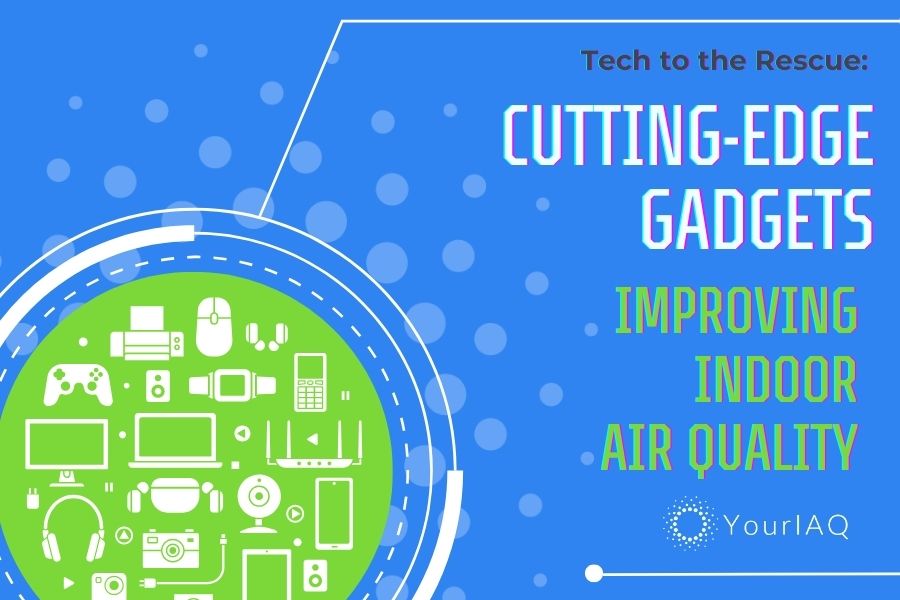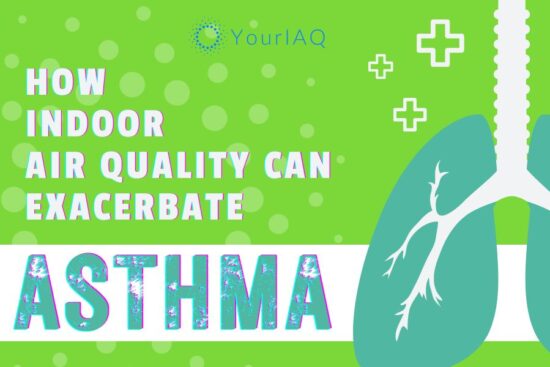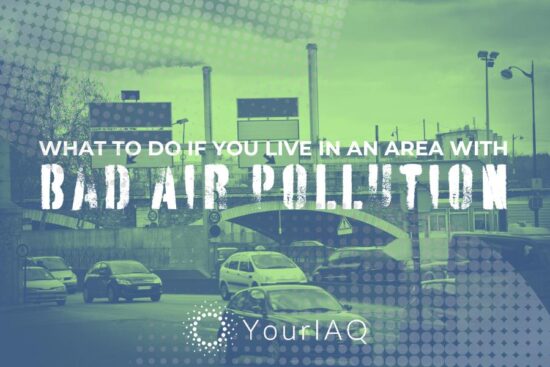
Indoor air pollution is responsible for 3.8 million lives lost each year globally, emphasizing the critical need for innovative solutions in air quality technology to combat indoor air pollutants such as dust, mold, volatile organic compounds (VOCs), and radon. With Americans spending approximately 70 years of their lifespan indoors, the significance of maintaining high indoor air quality to safeguard human health cannot be overstated.
This article explores new technology and gadgets that monitor and improve indoor air quality. It discusses smart air purifiers, IoT-enabled ventilation systems, sensor technology, mobile sensing, and air quality management systems. These advancements are setting higher air quality standards and creating healthier living spaces.
The Role of Artificial Intelligence in Predicting Air Pollution
Artificial Intelligence (AI) and machine learning (ML) are revolutionizing the way we predict and manage air pollution, offering unprecedented accuracy and real-time data. Here’s how:
- Predictive Modeling and Real-Time Detection: AI and ML-based models forecast air pollution trends, while AI-powered sensors and cameras provide real-time pollution detection. This dual approach enhances the accuracy and efficiency of air quality management systems.
- Smart HVAC Systems: Leveraging AI algorithms, smart HVAC systems dynamically monitor and adjust indoor air quality parameters, ensuring optimal living conditions.
- Advanced Simulation for Threat Prediction: AI tools utilized by researchers at APL and NOAA simulate atmospheric conditions to predict air quality threats, such as wildfire smoke movement. These enhanced models offer faster and more accurate forecasts by analyzing fewer, shorter data sequences, leading to reliable 10-day air quality forecasts.
Using technology like smart air purifiers and IoT ventilation systems is important in fighting indoor air pollution. These solutions help predict and prevent air quality problems before they get worse.
How Has Technology Monitored Air Quality?
Understanding the components of the air we breathe has been a vital concern for centuries. From early methods focused on simple observation, air quality monitoring has evolved dramatically.
Today, sophisticated technologies provide real-time insights into pollutants, empowering us to improve indoor and outdoor environments. Key devices and techniques include:
Smart Air Purifiers and Monitors
Devices like Amaircare, Foobot, and Awair utilize air sensors to track indoor air quality factors (PM2.5, VOCs, CO2, humidity, etc.) in real-time. Historically, knowing your indoor air quality meant sending samples to a lab and waiting for results. Smart monitors change the game by:
- Giving instant awareness: Real-time data displayed on apps or the device itself reveals fluctuations in air quality throughout the day.
- Identifying triggers: Did cleaning products spike VOCs? Does cooking increase particulate matter? This knowledge lets you make adjustments for healthier air.
- Optimizing air purifiers: Many smart monitors control compatible air purifiers, automatically ramping up filtration when pollution levels rise.
- Spotting trends: Data patterns help you spot seasonal allergies, the impact of new furniture, or changes in outdoor air quality affecting your home.
The data allows individuals to understand their air quality and take steps to improve it through ventilation or air purification.
Radon and Pollutant Detection
While smart home monitors provide a broad overview of indoor air quality, specialized devices offer a focused lens on potentially harmful pollutants:
Safety Siren Radon Detectors
Radon is a colorless, odorless radioactive gas that seeps into homes from the ground. It’s the second leading cause of lung cancer after smoking. Safety Siren radon detectors utilize various technologies (e.g., charcoal detectors, electret ion chambers) to measure radon levels over time. Knowing your home’s radon levels is crucial for potential mitigation efforts.
Low-cost Monitors for Gases
Affordable monitors focus on specific gases like:
- Carbon Monoxide (CO): This deadly gas emitted from faulty appliances can cause dizziness, headaches, and even death. CO detectors sound an alarm at dangerous levels, potentially saving lives.
- Carbon Dioxide (CO2): While not directly harmful at typical indoor levels, elevated CO2 indicates poor ventilation. CO2 monitors help you identify when it’s time to open windows and promote fresh air circulation for comfort and alertness.
- Other Gases: Some monitors track additional pollutants like nitrogen dioxide (NO2) or ozone (O3), particularly relevant in areas with high outdoor air pollution.
Why Specific Tracking Matters
Tracking specific pollutants is essential because they pose invisible threats undetectable by our senses. Specialized detectors act as our early warning system, pinpointing the source of these pollutants (faulty appliances, radon in the basement).
This targeted knowledge goes beyond simply treating symptoms, empowering us to address the root cause for improved air quality and health. Understanding your exposure to different pollutants allows for informed decisions about your environment and, if necessary, consultation with medical professionals for individual sensitivities.
Ultimately, knowing your home is safe from these silent dangers provides peace of mind, especially for those focused on health. While broader air quality monitors are useful, specialized devices offer an unmatched level of protection against specific, dangerous pollutants.
Grab Sampling vs. Continuous Monitoring: Advanced Sampling Techniques
Understanding air pollution requires different sampling approaches. Here’s the key distinction:
What is Continuous Monitoring?
As the name suggests, continuous monitoring involves collecting air samples over an extended period (hours, days, even weeks). Specialized instruments continuously draw in air, analyzing pollutants in real-time or storing data for later analysis.
What data it provides:
Continuous monitoring reveals trends, fluctuations, and peak pollutant levels. It helps identify pollution patterns related to the time of day, weather conditions, or specific activities within the monitored area.
What is Grab Sampling?
Grab sampling is a “snapshot” – a single air sample collected at a specific moment in time. The sample is then analyzed in a laboratory.
What data it provides:
Grab sampling gives a precise measurement of pollutant concentrations at the exact time and location of sampling. It’s helpful for confirming the presence of specific pollutants or comparing air quality across different locations.
Why Use Continuous Monitoring and Grab Sampling?
Using both continuous monitoring and grab sampling is advantageous because they offer complementary information. Continuous monitoring reveals how air quality changes over time, helping track patterns and fluctuations. Conversely, grab sampling provides a highly accurate snapshot of pollutant concentrations at a specific moment, aiding in deeper analysis.
The two methods have different strengths in application: continuous monitoring is ideal for tracking ongoing air quality near pollution sources or within sensitive environments, while grab sampling is often employed for regulatory compliance checks or pinpointing the exact source of a pollution event.
Emerging Cutting-Edge Technologies in Air Quality Monitoring
From AI-powered pollution prediction to air-purifying nanoparticles, emerging technologies are transforming how we monitor and improve indoor air quality.
Innovative Air Purification Technologies
UV-C Lighting & Hydrogen Peroxide Vapor
Both target viruses and harmful microorganisms. Here’s how they work:
- UV-C Lighting: Ultraviolet Germicidal Irradiation (UVGI) uses short-wavelength ultraviolet light (UV-C) to inactivate viruses, bacteria, and mold. As contaminated air passes through the UV-C light field, the light damages the genetic material of the microorganisms, preventing them from replicating and rendering them harmless.
- Hydrogen Peroxide Vapor: This technology disperses a fine mist of hydrogen peroxide throughout a space. Hydrogen peroxide acts as a powerful oxidant, breaking down the cell walls of viruses, bacteria, and other harmful microorganisms. It also neutralizes volatile organic compounds (VOCs).
HEPA Filters & Electrostatic Precipitation
Essentially, both trap pollutants to improve indoor air quality. To understand them better, here’s a quick overview of their mechanism:
- HEPA Filters: High-efficiency particulate air filters are made of dense, fibrous material. As air passes through the filter, various mechanisms (interception, impaction, diffusion) trap particles of different sizes, including allergens, dust, pollen, and some smoke particles. HEPA filters have efficiency ratings, with higher ratings indicating better filtration capabilities.
- Electrostatic Precipitation: These systems use an electrical charge to remove particles from the air. Air passes through an ionization section where particles receive a negative charge. The charged particles then pass through collection plates with a positive charge, which attracts and traps the particles.
Cold Plasma & Photocatalytic Oxidation
Cold plasma and photocatalytic oxidation neutralize pollutants with advanced methods. Specifically:
- Cold Plasma: Creates a field of charged particles (“plasma”) at room temperature. The plasma contains reactive species (e.g., ions, radicals) that break down pollutants on a molecular level. Cold plasma systems neutralize VOCs, odors, and some airborne pathogens.
- Photocatalytic Oxidation (PCO): PCO systems use UV light in combination with a catalyst, often titanium dioxide. When UV light hits the catalyst, it generates highly reactive molecules that break down pollutants like VOCs, converting them into harmless byproducts like carbon dioxide and water.
IoT-Enabled Solutions
IoT devices don’t just provide data – they trigger automated responses like air purifier activation and ventilation adjustments for optimal comfort and protection.
Automated Responses
Air quality monitors can connect to air purifiers, fans, or HVAC systems. They do more than just warn you about bad air. They automatically trigger air purifiers to ramp up, increase ventilation rates, or even send notifications to close windows when outdoor air quality worsens. This minimizes manual intervention and ensures swift action.
Smart Home Integration
Technologies like Control4 OS3 and Sensibo Air & Room Sensors personalize and regulate indoor environments for comfort and safety.
- Control4 OS3 integrates air quality monitors, allowing for sophisticated automation. For example, it automatically increases filtration if pollution levels rise, turns on dehumidifiers if humidity gets too high, or triggers scenes with optimal settings based on air quality data.
- Sensibo Air & Room Sensors monitor air quality and control your AC or heat pump. Combining data and control, they automatically adjust temperature and airflow based on environmental conditions for comfort and energy efficiency.
The Future of Air Quality Technology and Environmental Policy
Exciting developments in air quality technology and environmental policy promise a cleaner, healthier future. Here are a few key trends:
Legislative and Technological Synergy
The Clean Air Act’s achievements highlight the ongoing battle against air pollution. They underline the need for continued innovation in air quality technology to address health-based standards, climate change, and toxic pollutants. This collaborative effort between lawmakers and innovators sets the stage for continued progress in combating air pollution.
Innovative Building and Energy Solutions
Green building solutions prioritize energy efficiency and air quality through sustainable techniques like improved ventilation and eco-friendly materials.
Clean energy technologies, including solar and wind power, direct air capture (DAC), and carbon sequestration, offer promising paths to reducing emissions and combating air pollution.
Advanced Materials and HVAC Systems
The use of advanced materials such as graphene in paints and coatings contributes to safer indoor environments, preventing the growth of harmful microorganisms.
Modern HVAC systems, equipped with advanced filtration technologies and requiring regular maintenance, play a crucial role in maintaining and enhancing indoor air quality.
The anticipated growth of the indoor air quality monitoring device market, driven by the popularity of smart homes and technological advancements, underscores the increasing demand for innovative air quality monitoring solutions.
This diverse focus across residential, commercial, and industrial sectors demonstrates the far-reaching impact of air quality technology and its power to shape a healthier world.
Conclusion
We’ve seen the transformative power modern technology and innovative gadgets hold in enhancing indoor air quality, a quintessential component of healthier living spaces. From predictive AI models that offer accuracy in real-time air quality management to smart air purifiers and IoT-enabled ventilation systems that actively clean and monitor air, technology stands at the forefront of this essential environmental challenge.
These advancements not only herald a significant leap in our capacity to combat indoor air pollution but also underscore the importance of integrating such technology into our daily lives to safeguard health and well-being.
Encouraging further research and the adoption of these cutting-edge solutions can propel us towards a future where clean air is not a luxury but a standard, ensuring a healthier environment for generations to come.
Air Quality Technology FAQs
Air quality tech demystified! Find straightforward answers to your top questions:
Are air cleaners effective in reducing health risks?
Yes, especially for specific pollutants and when matched to the home’s air quality issues. However, effectiveness varies by pollutant type and cleaner capacity. Avoid ionizers and ozone generators due to potential harmful byproducts.
How is technology utilized to better indoor air quality?
Technological advancements have led to the development of large-scale filtration machines that are used in high-tech environments. These machines draw in air and filter out dust and other harmful contaminants during the workday, subsequently releasing clean air for the workforce and people in the vicinity to breathe.
Can you list some technological innovations that combat air pollution?
Some notable examples are High-Efficiency Particle Air (HEPA) filters, plasma ionization systems, and electrostatic air purifiers. These technologies are designed to remove pollutants directly from both indoor and outdoor air.
What air purification technologies have engineers designed to reduce air pollution exposure?
Engineers have designed a variety of air purification technologies, including HEPA filters that trap small particles and allergens, activated carbon filters that absorb chemicals and odors, and photocatalytic oxidation systems that use light to neutralize pollutants.
How can I improve indoor air quality in my home?
Use air cleaners with high MERV and CADR ratings. Regularly replace HVAC filters and consider UV-C lighting & HEPA filters for advanced purification.






